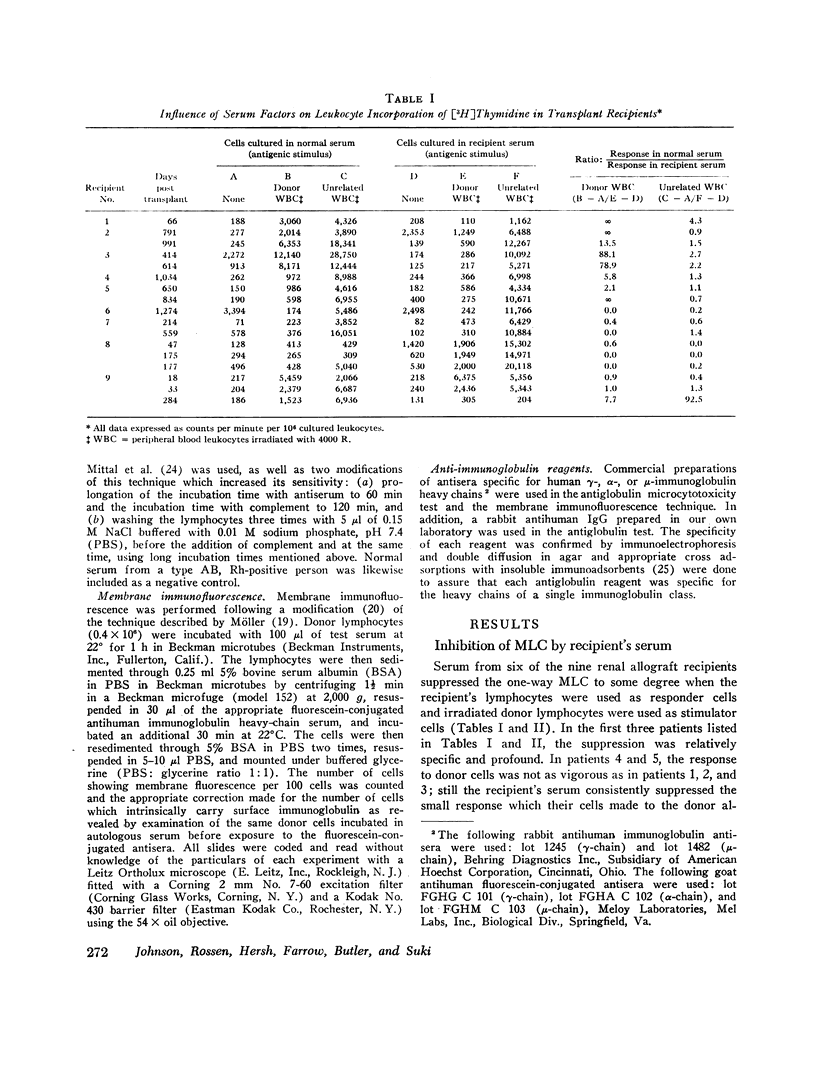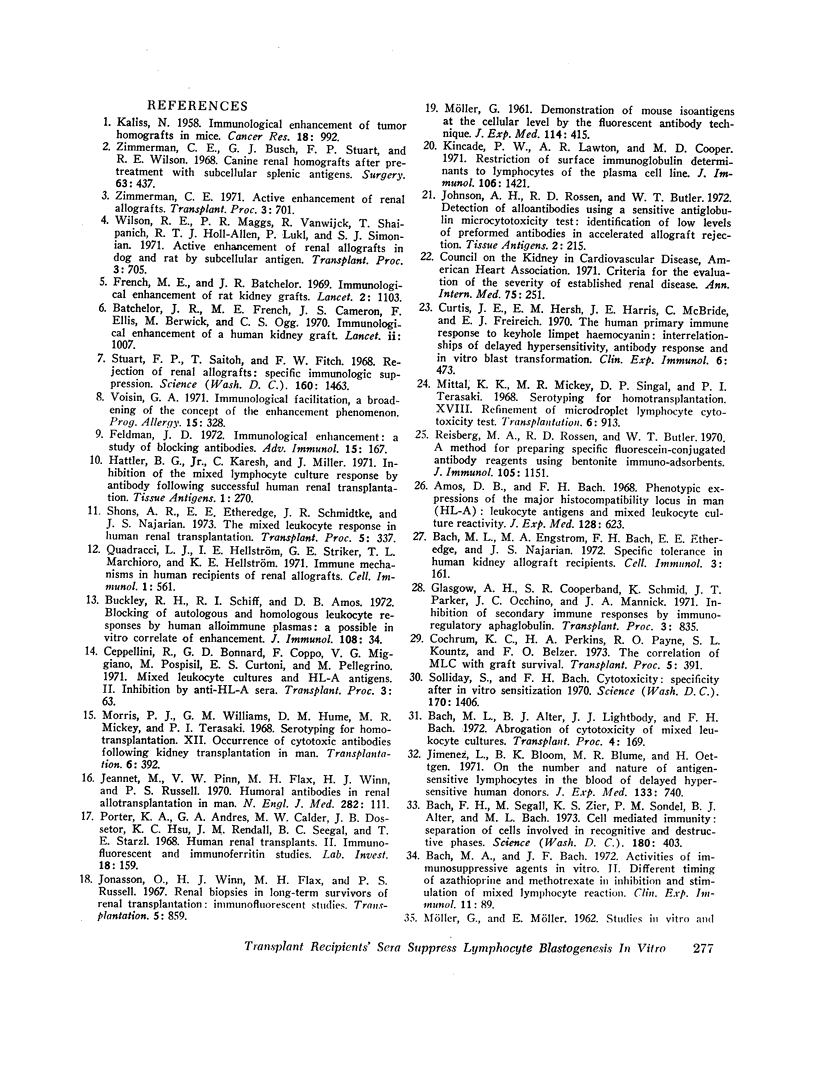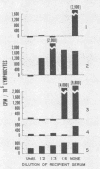Abstract
To evaluate whether immunological enhancement plays a role in adaptation to renal allografts, we studied sera from transplant recipients to determine whether those which suppressed mixed leukocyte culture (MLC) responses in vitro contained alloantibodies reactive with donor cells. Sera from five of nine renal transplant recipients consistently and specifically suppressed autologous autologous MLC responses to donor cells without impairing the blastogenic responses to third-party leukocytes, soluble antigens, or nonspecific mitogenic agents. In three of the five cases the suppressive activity of the serum was striking; in two cases the effect was less marked but still readily demonstrable in studies designed to evaluate the dose of serum which provided optimal suppression of MLC responses. Serum from one of the recipients nonspecifically suppressed blastogenic activity both to donor cells and other stimuli. No alloantibody reactive with donor leukocytes was found in any of the sera which exhibited suppressive activity in MLC, whereas in one patient, serum which contained antibody reactive with donor cells did not suppress MLC response to that donor. These findings suggest that, if the serum factors which suppress MLC responses in vitro are enhancing antibodies, they are not detectable even with very sensitive techniques either because they are present in very low concentrations, belong to immunoglobulin classes other than IgA, IgG, or IgM, or are complexed with donor antigen in such a way that their ability to react with fresh donor cells in vitro is blocked.
Full text
PDF








Images in this article
Selected References
These references are in PubMed. This may not be the complete list of references from this article.
- Amos D. B., Bach F. H. Phenotypic expressions of the major histocompatibility locus in man (HL-A): leukocyte antigens and mixed leukocyte culture reactivity. J Exp Med. 1968 Oct 1;128(4):623–637. doi: 10.1084/jem.128.4.623. [DOI] [PMC free article] [PubMed] [Google Scholar]
- Amos D. B., Cohen I., Klein W. J., Jr Mechanisms of immunologic enhancement. Transplant Proc. 1970 Mar;2(1):68–75. [PubMed] [Google Scholar]
- Bach F. H., Segall M., Zier K. S., Sondel P. M., Alter B. J., Bach M. L. Cell mediated immunity: separation of cells involved in recognitive and destructive phases. Science. 1973 Apr 27;180(4084):403–406. doi: 10.1126/science.180.4084.403. [DOI] [PubMed] [Google Scholar]
- Bach M. A., Bach J. F. Activities of immunosuppressive agents in vitro. II. Different timing of azathioprine and methotrexate in inhibition and stimulation of mixed lymphocyte reaction. Clin Exp Immunol. 1972 May;11(1):89–98. [PMC free article] [PubMed] [Google Scholar]
- Bach M. L., Alter B. J., Lightbody J. J., Bach F. H. Abrogation of cytotoxicity of mixed leukocyte cultures. Transplant Proc. 1972 Jun;4(2):169–172. [PubMed] [Google Scholar]
- Bach M. L., Engstrom M. A., Bach F. H., Etheredge E. E., Najarian J. S. Specific tolerance in human kidney allograft recipients. Cell Immunol. 1972 Jan;3(1):161–166. doi: 10.1016/0008-8749(72)90238-9. [DOI] [PubMed] [Google Scholar]
- Batchelor J. R., French M. E., Cameron J. S., Ellis F., Bewick M., Ogg C. S. Immunological enchancement of human kidney graft. Lancet. 1970 Nov 14;2(7681):1007–1010. doi: 10.1016/s0140-6736(70)92816-3. [DOI] [PubMed] [Google Scholar]
- Buckley R. H., Schiff R. I., Amos D. B. Blocking of autologous and homologous leukocyte responses by human alloimmune plasmas: a possible in vitro correlate of enhancement. J Immunol. 1972 Jan;108(1):34–44. [PubMed] [Google Scholar]
- Ceppellini R., Bonnard G. D., Coppo F., Miggiano V. C., Pospisil M., Curtoni E. S., Pellegrino M. Transplantation antigens: introductory symposium. Mixed leukocyte cultures and HL-A antigens. I. Reactivity of young fetuses, newborns and mothers at delivery. Transplant Proc. 1971 Mar;3(1):58–63. [PubMed] [Google Scholar]
- Cochrum K. C., Perkins H. A., Payne R. O., Kountz S. L., Belzer F. O. The correlation of MLC with graft survival. Transplant Proc. 1973 Mar;5(1):391–396. [PubMed] [Google Scholar]
- Curtis J. E., Hersh E. M., Harris J. E., McBride C., Freireich E. J. The human primary immune response to keyhole limpet haemocyanin: interrelationships of delayed hypersensitivity, antibody response and in vitro blast transformation. Clin Exp Immunol. 1970 Apr;6(4):473–491. [PMC free article] [PubMed] [Google Scholar]
- Feldman J. D. Immunological enhancement: a study of blocking antibodies. Adv Immunol. 1972;15:167–214. doi: 10.1016/s0065-2776(08)60685-9. [DOI] [PubMed] [Google Scholar]
- Feldmann M., Diener E. Antibody-mediated suppression of the immune response in vitro. I. Evidence for a central effect. J Exp Med. 1970 Feb;131(2):247–274. doi: 10.1084/jem.131.2.247. [DOI] [PMC free article] [PubMed] [Google Scholar]
- French M. E., Batchelor J. R. Immunological enhancement of rat kidney grafts. Lancet. 1969 Nov 22;2(7630):1103–1106. doi: 10.1016/s0140-6736(69)90705-3. [DOI] [PubMed] [Google Scholar]
- Glasgow A. H., Cooperband S. R., Schmid K., Parker J. T., Occhino J. C., Mannick J. A. Inhibition of secondary immune responses by immunoregulatory alphaglobulin. Transplant Proc. 1971 Mar;3(1):835–837. [PubMed] [Google Scholar]
- Gutterman J. U., Rossen R. D., Butler W. T., McCredie K. B., Bodey G. P., Sr, Freireich E. J., Hersh E. M. Immunoglobulin on tumor cells and tumor-induced lymphocyte blastogenesis in human acute leukemia. N Engl J Med. 1973 Jan 25;288(4):169–175. doi: 10.1056/NEJM197301252880401. [DOI] [PubMed] [Google Scholar]
- Hattler B. G., Jr, Karesh C., Miller J. Inhibition of the mixed lymphocyte culture response by antibody following successful human renal transplantation. Tissue Antigens. 1971;1(6):270–275. doi: 10.1111/j.1399-0039.1971.tb00105.x. [DOI] [PubMed] [Google Scholar]
- Haughton G., Adams D. O. Specific immunosuppression by minute doses of passive antibody. II. The site of action. J Reticuloendothel Soc. 1970 Apr;7(4):500–517. [PubMed] [Google Scholar]
- Hellström I., Hellström K. E., Bill A. H., Pierce G. E., Yang J. P. Studies on cellular immunity to human neuroblastoma cells. Int J Cancer. 1970 Sep 15;6(2):172–188. doi: 10.1002/ijc.2910060205. [DOI] [PubMed] [Google Scholar]
- Jeannet M., Pinn V. W., Flax M. H., Winn H. J., Russell P. S. Humoral antibodies in renal allotransplantation in man. N Engl J Med. 1970 Jan 15;282(3):111–117. doi: 10.1056/NEJM197001152820301. [DOI] [PubMed] [Google Scholar]
- Jimenez L., Bloom B. R., Blume M. R., Oettgen H. F. On the number and nature of antigen-sensitive lymphocytes in the blood of delayed-hypersensitive human donors. J Exp Med. 1971 Apr 1;133(4):740–751. doi: 10.1084/jem.133.4.740. [DOI] [PMC free article] [PubMed] [Google Scholar]
- Johnson A. H., Rossen R. D., Butler W. T. Detection of alloantibodies using a sensitive antiglobulin microcytotoxicity test: identification of low levels of pre-formed antibodies in accelerated allograft rejection. Tissue Antigens. 1972;2(3):215–226. doi: 10.1111/j.1399-0039.1972.tb00138.x. [DOI] [PubMed] [Google Scholar]
- Jonasson O., Winn H. J., Flax M. H., Russell P. S. Renal biopsies in long-term survivors of renal transplantation: immunofluorescent studies. Transplantation. 1967 Jul;5(4 Suppl):859–863. doi: 10.1097/00007890-196707001-00012. [DOI] [PubMed] [Google Scholar]
- KALISS N. Immunological enhancement of tumor homografts in mice: a review. Cancer Res. 1958 Oct;18(9):992–1003. [PubMed] [Google Scholar]
- Kincade P. W., Lawton A. R., Cooper M. D. Restriction of surface immunoglobulin determinants to lymphocytes of the plasma cell line. J Immunol. 1971 May;106(5):1421–1423. [PubMed] [Google Scholar]
- Klein W. J., Jr Lymphocyte-mediated cytotoxicity in vitro. Effect of enhancing antisera. J Exp Med. 1971 Nov 1;134(5):1238–1252. doi: 10.1084/jem.134.5.1238. [DOI] [PMC free article] [PubMed] [Google Scholar]
- Mittal K. K., Mickey M. R., Singal D. P., Terasaki P. I. Serotyping for homotransplantation. 18. Refinement of microdroplet lymphocyte cytotoxicity test. Transplantation. 1968 Nov;6(8):913–927. doi: 10.1097/00007890-196811000-00006. [DOI] [PubMed] [Google Scholar]
- Morris P. J., Williams G. M., Hume D. M., Mickey M. R., Terasaki P. I. Serotyping for homotransplantation. XII. Occurrence of cytotoxic antibodies following kidney transplantation in man. Transplantation. 1968 May;6(3):392–399. [PubMed] [Google Scholar]
- Oppenheim J. J. Modulation of in vitro lymphocyte transformation by antibodies: enhancement by antigen-antibody complexes and inhibition by antibody excess. Cell Immunol. 1972 Mar;3(3):341–360. doi: 10.1016/0008-8749(72)90243-2. [DOI] [PubMed] [Google Scholar]
- Porter K. A., Andres G. A., Calder M. W., Dossetor J. B., Hsu K. C., Rendall J. M., Seegal B. C., Starzl T. E. Human renal transplants. II. Immunofluorescent and immunoferritin studies. Lab Invest. 1968 Feb;18(2):159–171. [PubMed] [Google Scholar]
- Quadracci L. J., Hellström I. E., Striker G. E., Marchioro T. L., Hellström K. E. Short communication immune mechanisms in human recipients of renal allografts. Cell Immunol. 1970 Nov;1(5):561–566. doi: 10.1016/0008-8749(70)90042-0. [DOI] [PubMed] [Google Scholar]
- Reisberg M. A., Rossen R. D., Butler W. T. A method for preparing specific fluorescein-conjugated antibody reagents using bentonite immunoadsorents. J Immunol. 1970 Nov;105(5):1151–1161. [PubMed] [Google Scholar]
- Shons A. R., Etheredge E. E., Schmidtke J. R., Najarian J. S. The mixed leukocyte response in human renal transplantation. Transplant Proc. 1973 Mar;5(1):337–342. [PubMed] [Google Scholar]
- Simmons R. L., Russell P. S. Passive enhancement of neonatal skin grafts. Transplantation. 1967 May;5(3):551–555. [PubMed] [Google Scholar]
- Sjögren H. O., Hellström I., Bansal S. C., Hellström K. E. Suggestive evidence that the "blocking antibodies" of tumor-bearing individuals may be antigen--antibody complexes. Proc Natl Acad Sci U S A. 1971 Jun;68(6):1372–1375. doi: 10.1073/pnas.68.6.1372. [DOI] [PMC free article] [PubMed] [Google Scholar]
- Sjögren H. O., Hellström I., Bansal S. C., Warner G. A., Hellström K. E. Elution of "blocking factors" from human tumors, capable of abrogating tumor-cell destruction by specifically immune lymphocytes. Int J Cancer. 1972 Mar 15;9(2):274–283. doi: 10.1002/ijc.2910090205. [DOI] [PubMed] [Google Scholar]
- Solliday S., Bach F. H. Cytotoxicity: specificity after in vitro sensitization. Science. 1970 Dec 25;170(3965):1406–1409. doi: 10.1126/science.170.3965.1406. [DOI] [PubMed] [Google Scholar]
- Stuart F. P., Saitoh T., Fitch F. W. Rejection of renal allografts: specific immunologic suppression. Science. 1968 Jun 28;160(3835):1463–1465. doi: 10.1126/science.160.3835.1463. [DOI] [PubMed] [Google Scholar]
- Voisin G. A. Immunological facilitation, a broadening of the concept of the enhancement phenomenon. Prog Allergy. 1971;15:328–485. [PubMed] [Google Scholar]
- Voisin G. A., Kinsky R. G., Duc H. T. Immune status of mice tolerant of living cells. II. Continuous presence and nature of facilitation-enhancing antibodies in tolerant animals. J Exp Med. 1972 May 1;135(5):1185–1203. doi: 10.1084/jem.135.5.1185. [DOI] [PMC free article] [PubMed] [Google Scholar]
- Wilson R. E., Maggs P. R., Vanwijck R., Shaipanich T., Holl-Allen R. T., Lukl P., Simonian S. J. Active enhancement of renal allografts in dog and rat by subcellular antigen. Transplant Proc. 1971 Mar;3(1):705–707. [PubMed] [Google Scholar]
- Zimmerman C. E. Active enhancemant of renal allografts. Transplant Proc. 1971 Mar;3(1):701–704. [PubMed] [Google Scholar]
- Zimmerman C. E., Busch G. J., Stuart F. P., Wilson R. E. Canine renal homografts after pretreatment with subcellular splenic antigens. Surgery. 1968 Mar;63(3):437–445. [PubMed] [Google Scholar]



